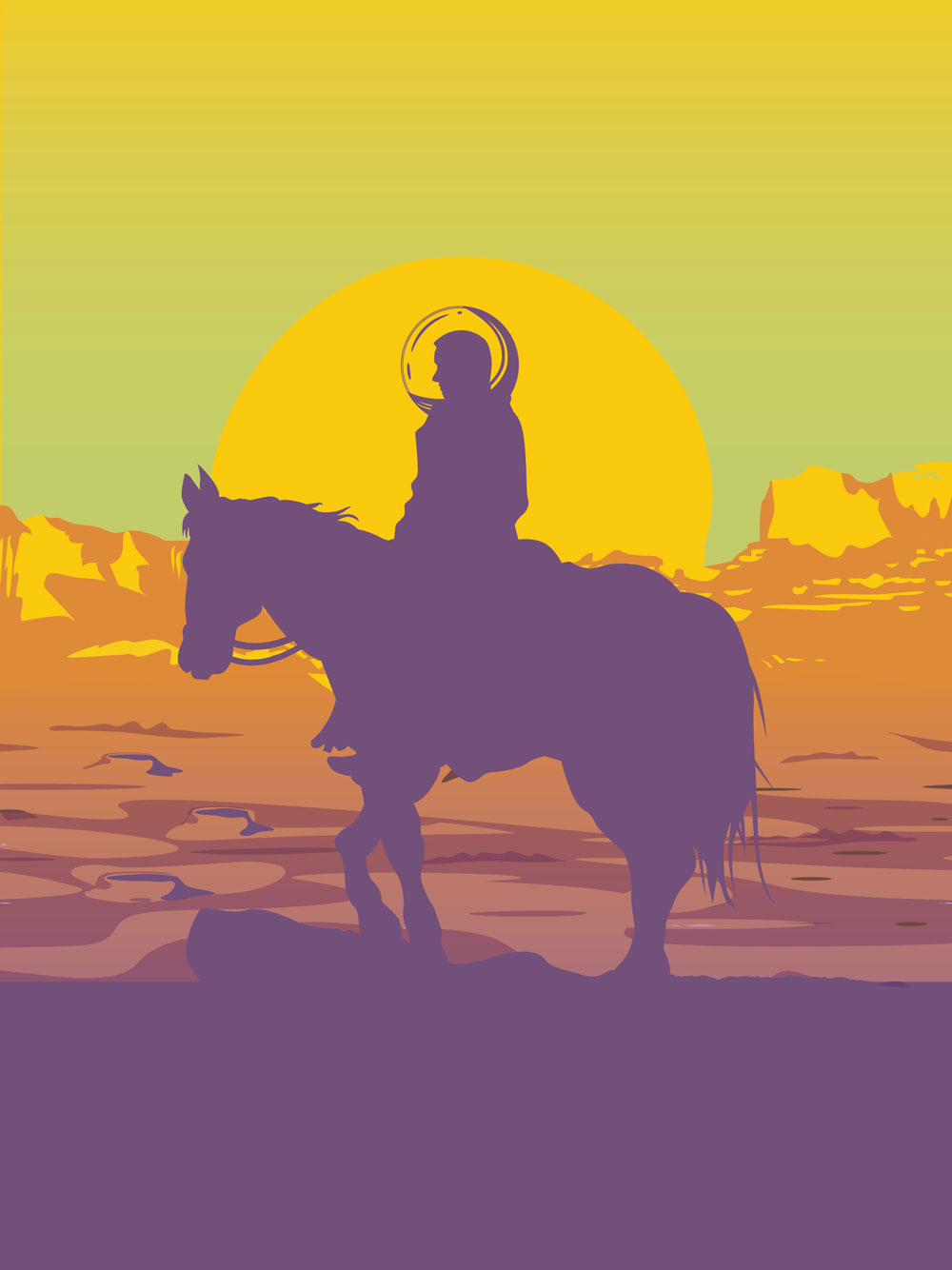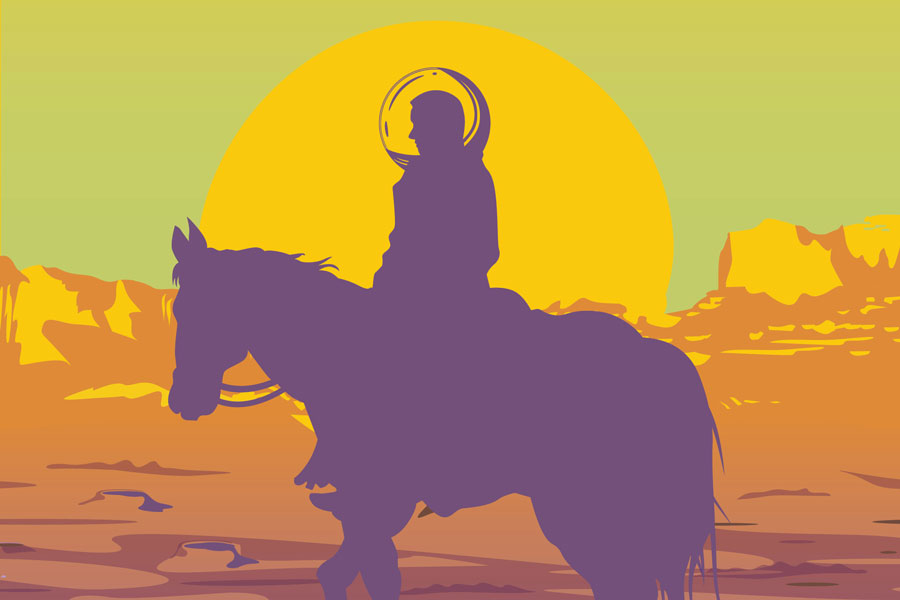Cowboys in Space and Fantastic Worlds
A journey through the history of Westerns in Science Fiction
On view July 13, 2019 to December 1, 2019
Inside the Exhibition
Spanning more than 150 years of Western and Science Fiction history, the exhibition features more than 100 artifacts, including toys, rare comics, pulp magazines, novels, original art, and props from movie and television. Highlighting famous and infamous characters popular with visitors of all ages, the exhibition sheds light on the influence of frontier history and Westerns in Science Fiction.
- Make your own Cowboys in Space comic book cover
- Listen to your favorite Space Cowboy songs
- Hear early Western and Science Fiction radio programs
- Watch how the cowboy travels to space in Western and Science Fiction film and television clips
- Hear the sounds of ray-guns, blasters, and phasers
Exhibition Sections
From Jules Verne's 1868 book, From the Earth to the Moon, Gene Autry's 1935 Phantom Empire, Star Trek, Star Wars, and on to a galaxy full of contemporary science fiction, visitors discover how the cowboy went from herding cattle on the Texas plains to flying spaceships around distant planets and fantastic worlds.
From Six Gun to Space Gun: Like Western cowboys, space cowboys carry guns. Gun-toting heroes and villains are recognized by their trademark weapons. Some writers have imagined a future where guns can be set to stun and not kill. To date, no NASA astronaut has traveled to space with a gun.
Cowgirls: In the 1800s, women’s roles were mostly defined as being subservient to men. Famous Wild West cowgirls like Annie Oakley and Calamity Jane — who could shoot guns and ride horses better than most men — were contrary to what was accepted by society. They showed that women were just as tough and courageous as cowboys. Though men predominately play the lead heroic roles, Science Fiction often presents a future for women where their courage, strength, and leadership are respected.
Native Aliens: Diverse aliens inhabit Science Fiction’s fantastic worlds. Their portrayals are often inspired by the first contacts made between American Indians and European colonists, where both sides saw each other as aliens. Science Fiction authors often give aliens the roles that American Indians filled in Westerns, set apart from the cowboy hero no matter what side they are on. They are depicted as fierce enemies, honorable rivals living in harmony with nature, or as allies and sidekicks to the cowboy hero.
Indigenous Futurism: American Indian authors and artists offer a future that does not celebrate the cowboy conquering new worlds. Their stories celebrate diverse American Indian cultures living on into the future.
The End?: Some Science Fiction authors envision an apocalypse on Earth. In their future, a lawless wasteland will remain, and the cowboy will be the only hope for justice to survive. Others celebrate our advancements in space technology and our ability to monitor the health and safety of our Earth. In these stories, astronauts like Western heroes defend our settlements.
Select Artifacts in the Exhibition
- From the Earth to the Moon, 1874 edition
In September of 1865, six months after the end of the American Civil War, French author Jules Verne published From the Earth to the Moon. The story presented a post-Civil War club of veterans who build a cannon to launch men to the moon. Foretelling the launch of Apollo 11 in 1969, Verne imagines three men are launched from Florida and land on the moon.
From the Earth to the Moon, 1874. Courtesy Cushing Memorial Library and Archives, Texas A&M University
- Buck Rogers
In the original story, Buck Rogers wakes up in the 25th century after being preserved for 500 years in a radioactive mine. He finds America has long since collapsed from a world war. Americans have splintered into tribes living in the wilderness and in underground complexes. Buck’s future America has returned to its frontier past.
Since 1929, different versions of Buck Rogers have appeared in books, comics, toys, radio dramas, film, television, and video games. The oldest running Science Fiction hero is still popular today.
Buck Rogers’s XZ-31 Rocket Pistol is the very first toy ray gun ever produced. Daisy released the toy at Macy’s department store for the 1934 Christmas season. To promote the gun, Macy’s created a “World of Tomorrow” section in their New York store, complete with rockets, moonscapes, and employees dressed like space travelers. The day the toy went on sale, lines stretched around the block.
Buck Rogers XZ-31 Rocket Pistol, 1934. Courtesy Johnny Etoile Collection
- Buster Crabbe
Olympic swimmer Larry “Buster” Crabbe starred in more than 100 movies. Made famous for his role as Tarzan, he went on to play Flash Gordon, Buck Rogers, and several Western cowboys. In this issue from Crabbe’s 1950s line of Space, Jungle, Western comics, he was abducted by aliens.
Buster Crabbe, Mar. #9, 1953. Courtesy Johnny Etoile Collection
The totem pole tradition among Pacific North West tribes was the inspiration for this Man from Mars Totem Head. This mail-order cardboard Martian helmet, from the 1950s television show Space Patrol, was offered on the back of cereal and Nestle’s Quik boxes.
Man from Mars Totem Head, 1954. Courtesy Johnny Etoile Collection
In 1987’s BraveStarr, Marshall BraveStarr is an orphaned American Indian from an unnamed tribe on planet Earth in the 23rd century. The lawman arrives to planet New Texas with an elder named Shaman. Thanks to the mystical elder, BraveStarr gains the powers of a hawk, wolf, puma, and bear. He protects settlers, and native Prairie People from the evil and greedy mining prospector Tex Hex. Town leader and BraveStarr’s friend, Judge J.B. McBride, makes certain that justice is always carried out fairly.
BraveStarr Animation Cel, 1980s. Courtesy Johnny Etoile Collection
- Pueblo Revolt 2180
Multimedia artist Virgil Ortiz uses traditional pueblo clay and contemporary materials, including costumes, props, and video, to propel his culture’s traditions and history into a Science Fiction future of his own making. He retells the story of the 1680 Pueblo Revolt — an uprising of Pueblo Indians against Spanish colonizers in present day New Mexico — as if it occurs 500 years after the original revolt in 2180.
Cuda
Cuda is one of the Aeronaut twins and the captain of the Survivorship Armada in Ortiz’s Pueblo Revolt story. The Aeronauts and their fleet fight against invading colonists. They preserve and protect their land, sacred clay, culture, language, and traditions from extinction.
Aeronaut, Courtesy Virgil Ortiz, Cochiti Pueblo, NM
Programs and Events
- Member and VIP Preview Costume Party
July 11, 2019 6:30 pm - 8:30 pm
Be the first to see the exhibition, while enjoying hors d’oeuvres and complimentary drinks, and live music. - Make it Tuesdays: Postcards from Space
July 16, 2019 10:00am - 12:00am
Channel your inner alien or astronaut with Giddyup Art Studio and create a postcard to send home from space. - Summer Family Film Series: Lilo & Stitch
July 20, 2019 2:00pm - 3:30pm
Join us for a family-friendly, multi-sensory screening of Lilo & Stitch, with a family activity included prior to the film. - Make it Tuesdays: Alien Alter Ego
July 23, 2019 10:00am - 12:00pm
Use your imagination to create an alien alter ego and explore the Cowboys in Space exhibit in your extraterrestrial best. - High Noon Talk: History Through Comics
August 7, 2019 12:00pm - 1:00pm
Comic books are more than just entertainment, come see why. - Sense-Sational Thursdays: Cowboys in Space
August 8, 2019 10:00am - 12:00pm
Pull on your boots and tip your hat as we blast off into space. - Cool Summer Nights 2019: Space
August 9, 2019 6:00pm - 9:00pm
The final Cool Summer Nights will take inspiration from the exhibition and all things space related. - Summer Family Film Series: WALL-E
August 10, 2019 2:00pm - 3:30pm
Join us for a family-friendly, multi-sensory screening of WALL-E, with a family activity included prior to the film. - Storytime: Blast Off!
August 22, 2019 10:00am - 11:00am
Blast Off! We will take you out of this world as we explore space travel. - B Movies and Bad History: Cowboys in Space
September 24, 2019 7:00pm - 8:30pm
See the best (and worst) examples of sci-fi westerns on-screen, and explore the meaning behind them. - Storytime: Over the Moon!
September 26, 2019 10:00am - 11:00am
Fly high with us as read and learn all about our moon. - Evenings Out: Cowboys in Space
November 14, 2019 6:00 - 8:00 pm
Enjoy a fun night out and an after-hours chance to explore Cowboys in Space and Fantastic Worlds. Play the best sci-fi arcade titles, snap a photo in a photo booth, and check out some of your favorite characters on screen in the Texas Spirit Theater. Includes food, games, and tours of the exhibition.
Media Contact
| General Inquiries | |
|---|---|
| 512-463-5424 | |

